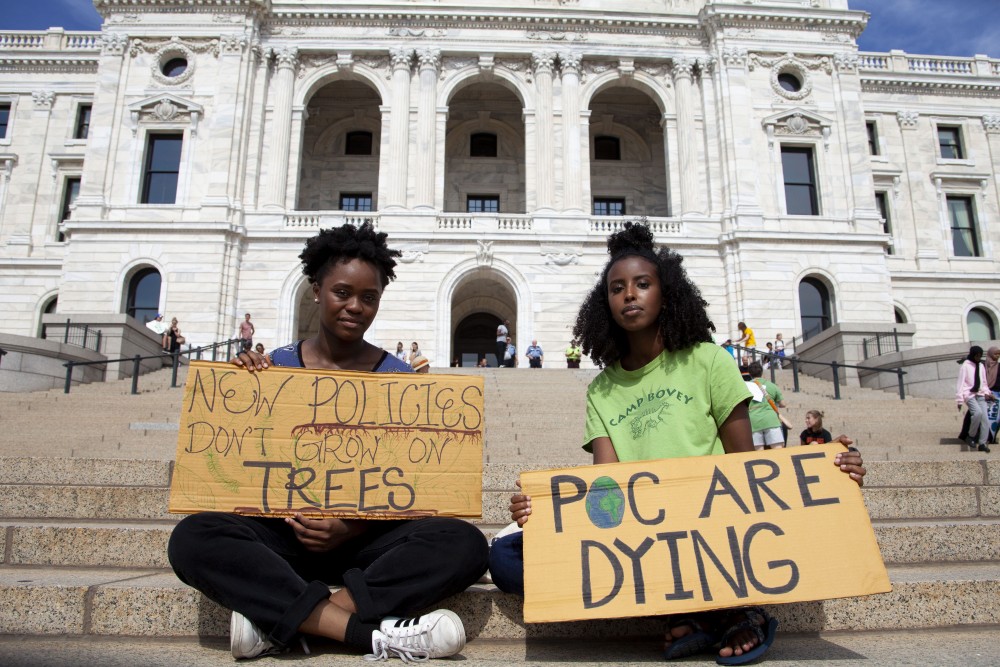Joining millions of protestors scattered across 150 countries, thousands turned out to speak against climate change in St. Paul Friday.
An oppressive heat settled over the Minnesota Youth Climate Strike as participants marched to the Capitol Building, gathering at the Western Sculpture Park in protest of what organizers call the “climate crisis.”
Speakers included students and organizers from around the state, with speeches centered around the intersections of the “climate crisis,” the oppression of marginalized people, and what they call a lack of response from politicians and civil leaders. Speakers said that marginalized people were impacted first by the climate crisis, often to a greater degree than those with more systemic privilege.

MN Youth Climate Strike is a branch of the U.S. Youth Climate Strike, a national organization “that works toward engaging, advocating and organizing youth about the climate crisis and getting people involved,” said Juwaria Jama, a 15-year-old high school sophomore at Spring Lake Park High School and co-state lead for the strike.
Jama said she became passionate about the environment and the intersectionality between climate change and oppression after noticing the effects of climate change in her community.
“Something that’s very important to the Minnesota Climate Strike is uplifting voices of communities of color and low-income communities that have been disproportionately affected by the climate crisis,” Jama said.
Protestors voiced a strong level of commitment to supporting and advocating for what many speakers said were “black and brown bodies” thrown in the path of climate change.
As much as she wants to inspire a gathering, Jama’s goals are very much grounded in a sense of importance.
“We are hoping to be able to inspire people, but also have people understand that there is a sense of urgency within the climate crisis,” she said.
Protestors at the strike seemed absorbed by this sense of urgency. Waves of chants rippled across the protestors, with slogans like “your mistakes are my future,” and “hey, hey, ho, ho, fossil fuels have got to go.”

Protestor Jess Sendin was inspired by her own generation’s involvement in climate change. “[Climate change] is human-made and shameful,” she said. “The environment was one of the first things that I was political about and we didn’t do a very good job in sorting that out in my generation.”
The strike was supported by organizations like MN350, a local environmental advocacy group, which banded together to support the strike.
“The real leaders of the climate strike are the youth who’ve pulled this all together,” said Brett Benson, communications director for MN350. “There’s 500 organizations that are partnered and supporting the youth, including MN350.”
The University of Minnesota’s Health Students for a Healthy Climate, which focuses on the intersection of healthcare and environmentalism, also participated in the strike.
Jack Inglis, a medical student and member of HSHC, mentioned how difficult it was for he and fellow medical students to be excused from their other duties. “I just told the superiors that this is something we’re doing and we’d like it excused. It’d be a bad look for administrators to prevent the health care community from showing up to something like this . . . They were pretty receptive.”
There was also a strong presence from religious organizations, with groups like the First Universalists Church of Minneapolis and Minnesota Interfaith Power and Light showing their support of the movement.
“We’re demonstrating for the youth, who we hope to see coming out,” said Judy Gobel, a member of the FUCM.
Though the strike was primarily a youth-oriented movement, Gobel said she noticed that large segments of the crowd seemed to belong to older generations.
“We seem to be mostly old here, but we’re hoping they’re on the other side of the crowd,” she said.








